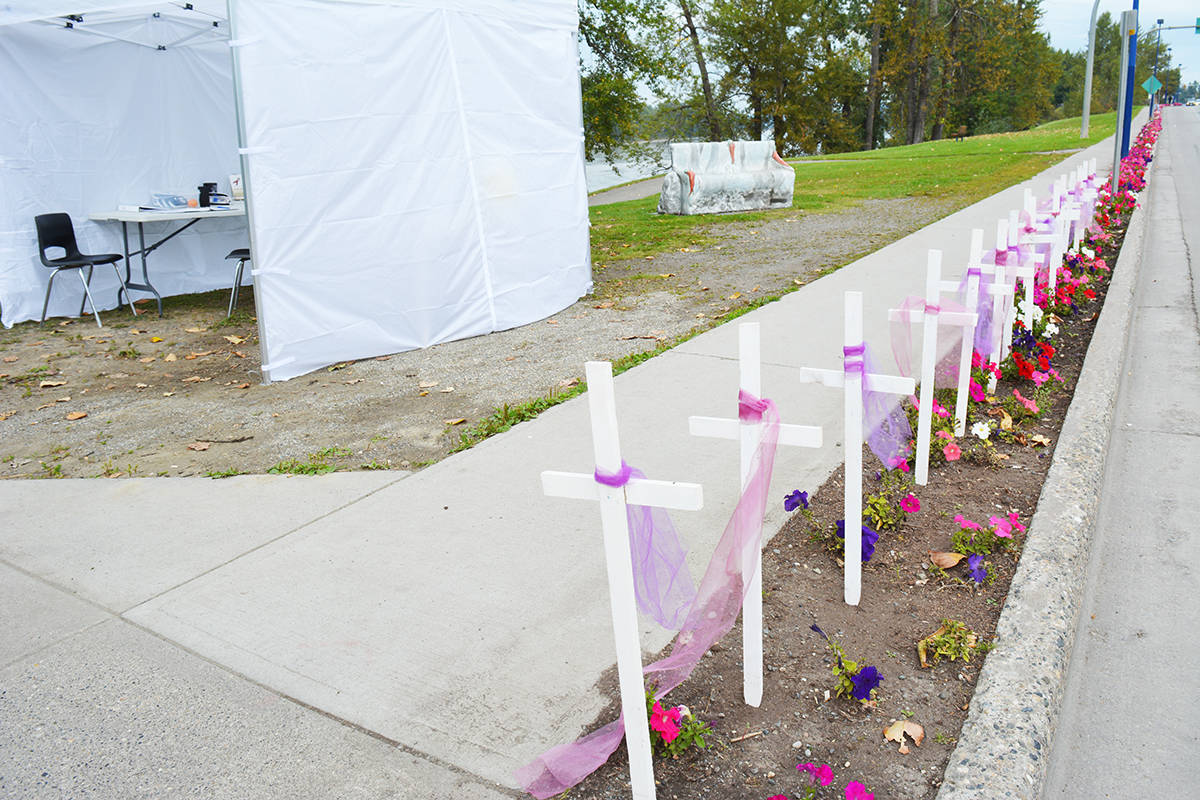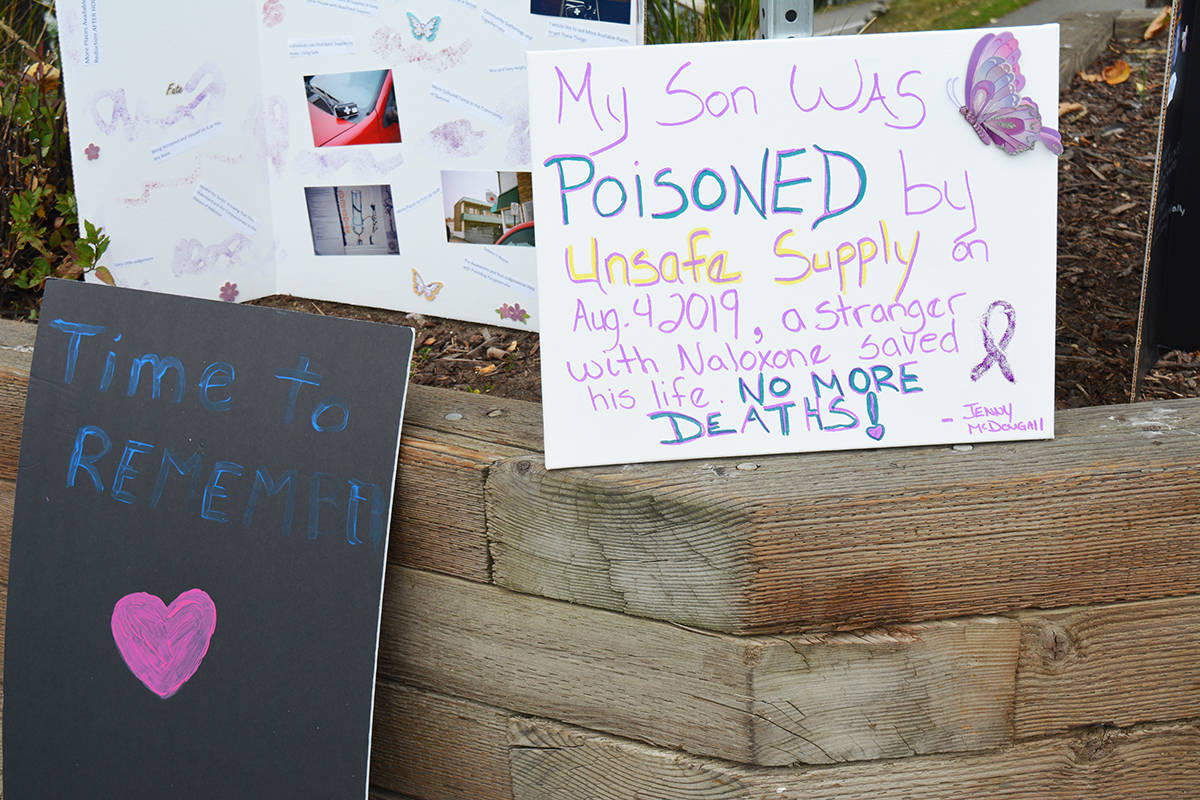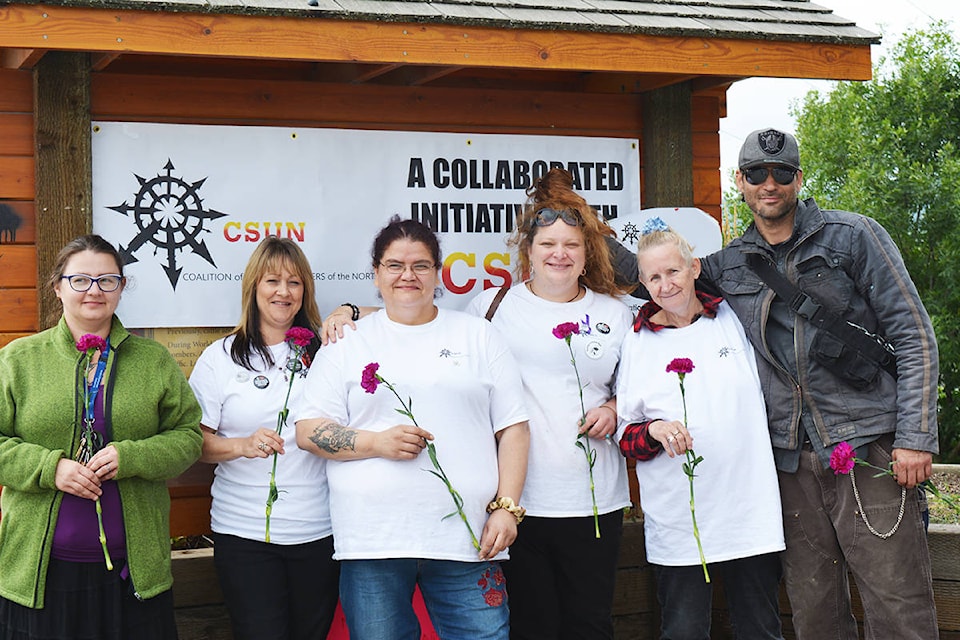At exactly noon on Saturday (Aug. 31), about 20 people stood at the halfway point of the Fraser River Footbridge and tossed purple and white carnations into the water.
It was a thoughtful and emotional moment following a minute of silence. Volunteers with the Coalition of Substance Users of the North (CSUN) offered the flowers to anyone impacted by the overdose crisis during the group’s International Overdose Awareness Day event, and they were meant to be thrown over the bridge in remembrance of those who have lost their lives, suffered injury or continue to struggle with substance issues.
A mock Overdose Prevention Site was set up, and volunteers provided naloxone training.
Louise Wannop, a CSUN volunteer who is also a volunteer outreach worker at Seasons House, says a lot of people on the streets are carrying naloxone kits, and they are saving lives because often, people who are using drugs don’t want to go to the hospital when something happens.
Charlene Burmeister, CSUN’s president and founder, says while many lives are being saved, there are still too many people dying of overdoses each day.
“We still need to be focused on the amount of Canadians who are dying each day,” she said. “It’s really important we keep shining the light on overdoses.”
As an organization, CSUN demands decriminalization of drugs, safe supply and drug policy changes at all levels of government.
Burmeister notes that alcohol is regulated and cigarettes are filtered, and they want substance use treated in a similar way where if people are going to use substances, at least they know those substances are safe.
“We deserve the same safe supply as other substance users from a harm reduction approach,” she said, pointing out there are safe consumption sites for alcohol on many street corners, and there has been a safe supply of alcohol since the end of Prohibition. “There’s this really backwards approach because of the stigma of drug use, and it’s such old thinking.”
Wannop is also a firm believer in the need for safe supply.
“When you have safe supply, people can be proactive members of society,” she said. “They can have jobs, hope, so much more than they have now.”
For Burmeister, Saturday’s event was about education and awareness as well as respectful engagement.
“I think it’s really important community members started to think logically about drug use,” she said. “The DSM-5 (Diagnostic and Statistical Manual of Mental Disorders) recognizes addiction as a disease, yet for some reason, because of the stigma of drug use, we are failing to provide safe supply and a pathway of hope. Drug use is a social issue and should not be deemed as a lack of moral decision-making. We need to educate and start changing the way people look at drug use.”
At the event, CSUN volunteers were collecting signatures from people who oppose the City of Quesnel’s proposed changes to its nuisance bylaw, which proposes fines for panhandling and sitting or sleeping on certain blocks of the downtown core during spring and summer months, among other things.
“In Quesnel, we have a lot of crime right now, and the City and the public are really aware, but I think where the City is trying to lead us is the wrong decision,” said CSUN volunteer Dawn Cameron.
Cameron believes the right direction would be creating a low-barrier social space where people can be all the time.
“There are a lot of people who are restricted from the shelter right now, and where can they go?” she said, noting people need a space where they can sit and talk to people and do something like watch television to distract themselves from their troubles. “When you have nothing to do, your troubles are with you all the time, 24/7. If we had a low-barrier social space, people who are panhandling could go there, and people could drop [money] off or drop off bottles and cans or food. I think that’s the solution, creating space — not taking it away because they already don’t have any.”
Cameron believes a lot of people in our community are not aware of all the drug use that goes on, and they think all the drug use is on the streets, but there is a lot of blue-collar drug use — and those people are dying of overdoses because they are using alone.
“I think the important thing about today is we are supposed to be remembering the people we’ve lost, and there are many people who are affected in our community,” she said.
Brandy Beaulieu, who is almost 18, was at the CSUN event because she is starting a survey for youth who come from a home that is affected by addiction. She is asking questions such as “are you aware of youth services” and “how does this affect your life.”
Saturday was the first day she was collecting information, and she was planning to head to LeBourdais Park later that afternoon to speak to youth at the Wild Women of the North Society’s International Overdose Awareness Day event.
Beaulieu plans to collect all the data and create a graph, and she hopes to get sponsorship so she can start up a youth group to help youth affected by addictions and overdose.
“I thought a youth group would be a good place to go, for people to talk,” she said. “It’s a hard thing to go through alone, and everyone should have a friend.”
READ MORE: ‘We provide someone to talk to, and that’s important’
editor@quesnelobserver.com
Like us on Facebook and follow us on Twitter


